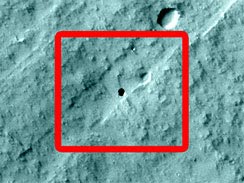The 7th grade student group discovered a mysterious cave on Mars
A group of 7-year-old students in California, USA discovered a mysterious cave on Mars when participating in a project to study images taken by a NASA spacecraft around the ' Red Planet '.
16 students from Evergreen School in Cottonwood, California, found a point that seems to be Mars's " window " - actually the mouth of a cave on Mars.
This group of students is participating in a program to study Mars images for students at the ' Red Planet ' research center at Arizona State University. The program allows students to ask questions and then control a camera operating around Mars to take pictures to answer questions.
The new cave was discovered similar to the holes seen on other areas of Mars in a study by American scientist Glen Cushing in 2007.
Cushing said these unusually giant craters are like rooftop windows - where a portion of the upper surface of caves or lava tubes subsides, creating a crater .
 The caves are believed to form due to volcanic activity on " Red planet ". The lines of jelly seemed to have created large caves in the rocky ground, and formed tunnels or ' lava tubes ' when the eruption ended. The surface of these caves can then collapse, creating craters.
The caves are believed to form due to volcanic activity on " Red planet ". The lines of jelly seemed to have created large caves in the rocky ground, and formed tunnels or ' lava tubes ' when the eruption ended. The surface of these caves can then collapse, creating craters.
However, scientists are not sure what craters contain substances or compounds inside .
Mr. Cushing estimated the cave mouth that the students found 190x160m wide and at least 115m deep.
Initially, young researchers aim to find lava tubes - a consequence of the volcanic activity commonly seen on Earth and Mars.
' Mars ' research program is one of the most exciting educational programs ever developed, ' said teacher Dennis Mitchell. ' The program helps students understand how research is conducted and why studies are important to the scientific community. This is an interesting experience . '

Mysterious cave mouth on Mars.
- Humans can stay in Mars and Moon caves
- The 9th grade student invented a mosquito repellent from tea residue
- 'Aliens' cave mystery in Australia
- Thanh Hoa: a 9th grade student successfully designed an electric wheelchair model
- The mystery of the 'strange smoke' on Mars
- NASA deciphered the strange white light on Mars
- 57 newly discovered caves in Quang Binh
- Mysterious cloud on Mars
- Trapped in a cave, how long can humans live?
- Mysterious handprints in ancient cave
- The cave is larger than Son Doong
- 6th grade student invented robot
 Van Allen's belt and evidence that the Apollo 11 mission to the Moon was myth
Van Allen's belt and evidence that the Apollo 11 mission to the Moon was myth The levels of civilization in the universe (Kardashev scale)
The levels of civilization in the universe (Kardashev scale) Today Mars, the sun and the Earth are aligned
Today Mars, the sun and the Earth are aligned The Amazon owner announced a secret plan to build a space base for thousands of people
The Amazon owner announced a secret plan to build a space base for thousands of people